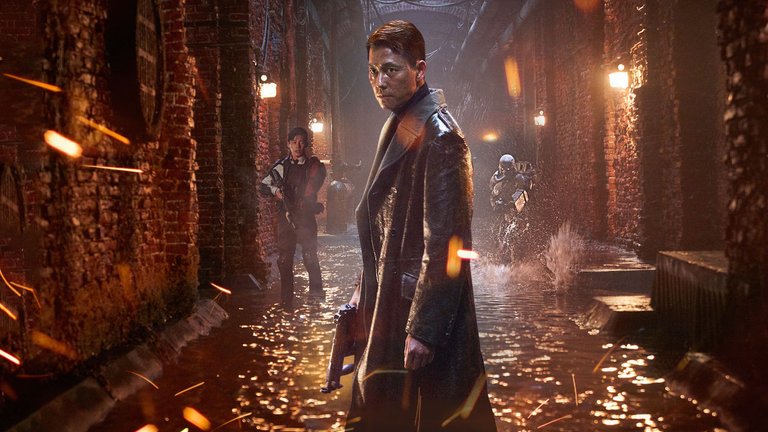
Why such a badass and… Nazi (?) officer is in such a filthy sewer? More, in our next episode | Source: Netflix
To talk about Mamoru Oshii (Tokyo, 1951) usually means to talk about one of the most recognized writers and directors in the anime industry. With a career of more than thirty years behind both the pen and the director's chair, Oshii became famous in his country for adapting Urusei Yatsura (1981-1986), a comedy manga written by the legendary mangaka Rumiko Takahashi, to the small screen. Subsequently, he participated in the creation of two OVAs (original video animation) for Mobile Police Patlabor (1988-1994), an intellectual property created by HEADGEAR - a collective of artists and writers in which he is an integral part of – that was adapted to theaters in two films, Patlabor: The Movie (1989) and Patlabor 2 (1993).
However, for much of his western audience, Mamoru Oshii's name is closely related to the referential and classic adapted masterpiece, Ghost in the Shell (1995). Originally inspired in the manga created by Masamune Shirow in 1989, critics and audience alike consider it one of the best anime feature films of all time. GitS not only was able to influence Western filmmakers such as James Cameron and the Wachowski sisters - who admit that much of their own work, especially the Matrix films, has been inspired by it – but also created a huge franchise that comprises videogames, animation and films.
Therefore, you would be shocked to know that none of these works is the most personal of the aforementioned Japanese director and writer. That honor goes to the Kerberos saga (1986-present), a military science fiction franchise that, with nearly thirty published works, has spread itself through mediums as diverse as anime, manga, film and radio dramas with great public and critical acclaim. Sadly, save for Oshii's habitual followers, knowledge of the Kerberos saga in the rest of the world is relatively and unfairly low.

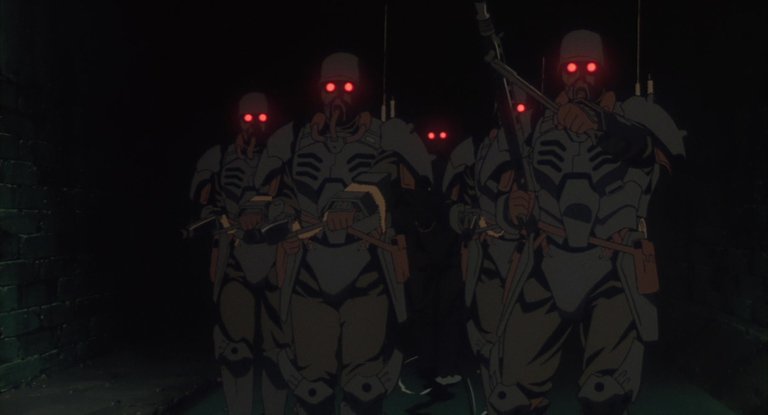
One of the most iconic character designs ever… and the final solution that many over the world would wish that certain, um, political issues had | Source: SolGravionMegazord @ DeviantArt
The different stories of the Kerberos saga tell us of a post-World War II ucrony in which, after a series of historical incidents - Japan allying itself with the Allies, Germany succeeding in its invasion of Russia and Hitler being replaced by Claus von Stauffenberg in the aftermath of a successful Operation Valkyrie - the Asian country is occupied and invaded by an expansionist and more efficient German war machine, in what will be known as the Weimar Establishment.
The German occupation of Japan officially ends on February 26, thanks to a coup d'état - based on the true story of said coup, although the one we know was against the Emperor's loyalists... and failed - of a special military brigade within the Japanese army, but the damage is already done. Soon, a fascist and totalitarian government led by a military junta with close ties to the German regime replaces the previous constitutional monarchy. The now infamous military brigade, Special Unit Kerberos and its men, become the protagonists of Mamoru Oshii’s breakthrough franchise, with its missions and constant conflicts with the Japanese government becoming a great part of its narrative material.
Of Oshii’s many works based in this intellectual property, the one that rose to international acclaim is Jin-Roh: The Wolf Brigade (1999), written by him and directed by Hiroyuki Okiura. Although the film created mixed feelings in critics - partially encouraged by the slow pace of its rhythm and the philosophical nature of its content, fundamental characteristics of its creator's oeuvre - at the time of its premiere, eventually it has gained a cult following as a masterpiece of Japanese animation.
Therefore, when Lewis Pictures and Warner Bros. Pictures Korea announced in 2013 that they would produce a live-action version of Jin-Roh: The Wolf Brigade, with renowned action film director Kim Jee-woon heading the project, expectations quickly rose to the stratosphere. Netflix quickly bought the international distribution rights to the film, which premiered on July 25, 2018 in South Korea, and Warner Bros. Korea selected it to compete in the San Sebastian International Film Festival, which took place in September 21-29 during this year.
Titled Illang: The Wolf Brigade (2018), this adaptation is perhaps one of the most difficult-to-review anime or manga-based films I have ever watched.
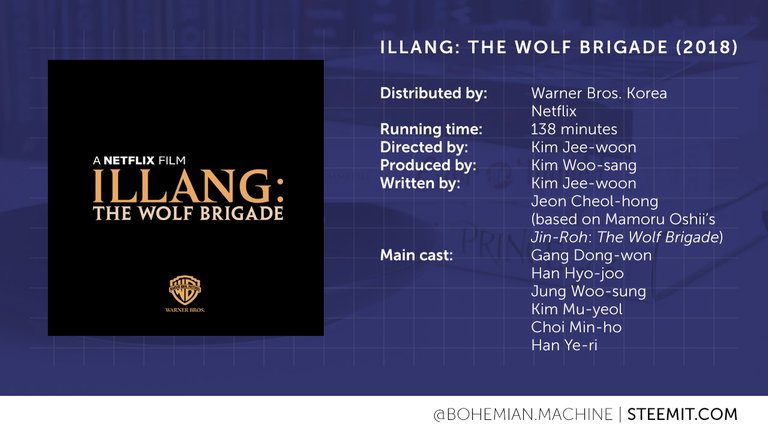

The Korean adaptation of Jin-Roh (which, depending on your source, will be either named Illang or Inrang), given the competition that a World War II-based ucrony - Amazon's The Man in the High Castle (2015-present), so to speak - might have faced in these times, makes a major alteration of the original plot. For the history that concerns us does not happen in a militaristic and fascist Japan, but in a unified Korea in the brink of civil war. After the terrible reception that said breakthrough has had in the perceived political and economic progress of the country, intense turmoil – both external and internal - forces the government to resort to isolationist politics and general repression to maintain itself in power.
On the outside, the combined threat from China, Russia, the United States and Japan, increasingly suspicious of what this unified Republic of Korea could represent in the international markets; on the inside, the threat posed by a large part of the population protesting against the government, spurred on by a paramilitary and terrorist group known only as the Sect. In order to counter such pressure, the Korean government creates its own response; the Special Unit, an anti-terrorist squad of highly trained and armed men who are in charge of reducing and overpowering any destabilizing attempt that the Sect manages to inflict against the country’s central authority.
However, the Special Unit’s public regard, both by the people and the government, is becoming increasingly low. After a violent incident in which at least twenty female students, erroneously associated with the Sect, die at the hands of the Special Unit’s heavy machineguns, its members end up as outcasts, with the Korean people increasingly at odds with their bloody tactics. To top it all, the many intrigues taking place in different sectors of the Korean government, especially those instigated by the Ministry of Internal Affairs - bitter enemies of the Special Unit - puts this purposefully lawful force’s backs against the wall in the first few minutes of the film.
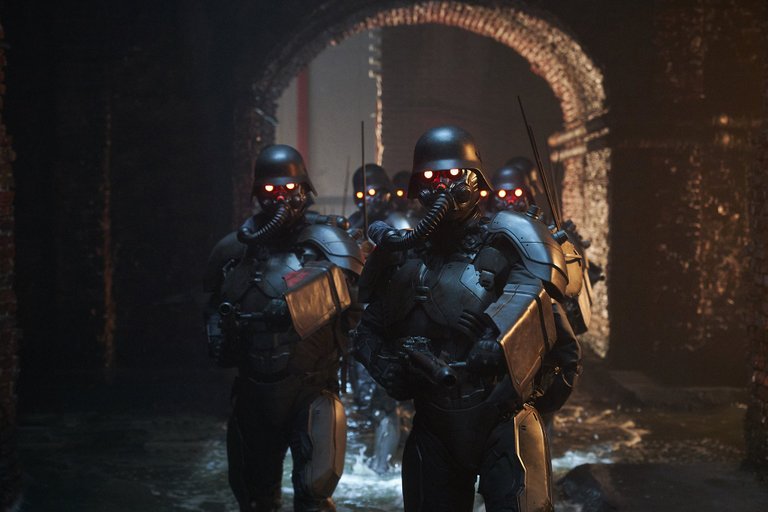
One of the most remarkable things about Illang: The Wolf Brigade is the fidelity of the Panzer Suits’ design | Source: Furyosa
The first event of Illang's plot does little to help increase the Special Unit’s approval: a massive riot, in an unspecified city, is infiltrated by Sect members and quickly becomes an uprising. As duty calls, the Special Unit takes control of the situation in the way they trained to deal with; breaking into a Sect hideout in the city's sewers, exterminating all its members and destroying any evidence of their existence.
However, the military operation’s results are anything but efficient. A Special Unit young officer, named Im Joong-kyung, has serious doubts while dealing with a red hood - young women recruited by the Sect who serve as messengers and errand girls of the high ranks of the organization, frequently armed with explosives. Pressed by the circumstances, the girl commits suicide, confusing the young officer, sending him to forced suspension and delivering a hard blow to the already worsened integrity of the Special Unit in the eyes of politicians and citizens alike.
This event, which forces the Special Unit to withdraw and lick its wounds, is used by the Ministry of the Interior to initiate an internal investigation into the organization, looking for any reason that would allow them to give the final blow to that wounded animal. Im Joong-kyung, encouraged by one of his superiors to hand over the belongings of the girl who died in the protests to his older sister, will soon be involved, not only in a tense and forbidden romance with her…
… but in a cruel conspiracy that aims to give the coup de grace to the Special Unit, in order to dismantle it and to completely make it dissapear.
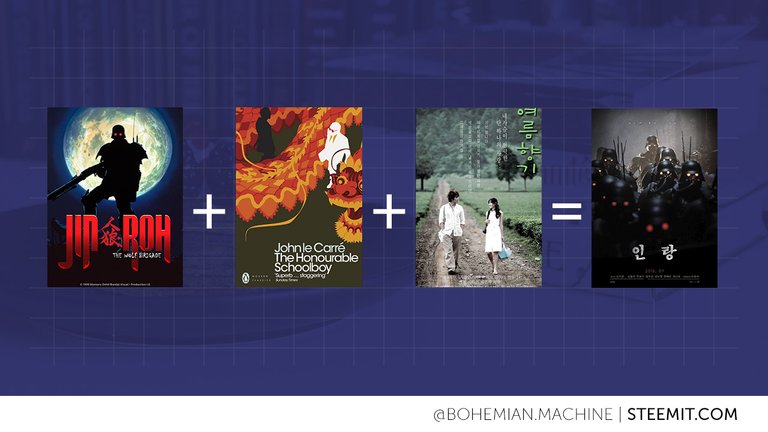
In view of the intriguing plot of espionage, political corruption and conflicting organizations laid down by Jin-Roh, it is easy to expect Illang to be a great entertainment, given the ability of Korean filmmakers to make productions with stories of great moral and philosophical conflicts. Truth be told, Illang fulfills this in its first act. Not only by translating this tension to the big screen, but by presenting a modernization of the original plot that, although it is not perfect and has some strange plot holes - would South Korean democracy really succeed, for example, in becoming a fascist state in the purest style of its northern enemies? - does manage to capture the sharp political problems that a country in a similar situation would face.
The problem is that, of course, a plot is often as good as its delivery...
... and this is where Illang, almost resoundingly in some spots, fails.

Illang's direction, in terms of cinematography and artistic direction, is simply breathtaking. Kim Jee-woon's work, with a budget that is presumably much shorter than those usually enjoyed by similar Hollywood productions, gives those a run for its money both in its way of creating virtually perfect replicas of Jin-Roh's original frames and in endowing the film with a very dark and crude aesthetic. Likewise, the special effects of the film are usually superb, with only a few mistakes in its CGI and with a competent art direction, creating an oppressive and realistic atmosphere during most of the film.
However, Illang undoubtedly ends up biting more than it can chew.
This happens mainly because of a much-needed side note: we need to understand the South Korean zeitgeist. To understand the thought process behind this Asian economic and cultural giant that, naturally and in the face of a cultural product this size and scope, will incur in exporting the best of itself and its idiosyncrasy. Because of this, Illang’s plot, treated at first as a fully-fledged political drama...
... ends up becoming a very strange, convoluted and scattered example of a k-drama on its second and third acts.
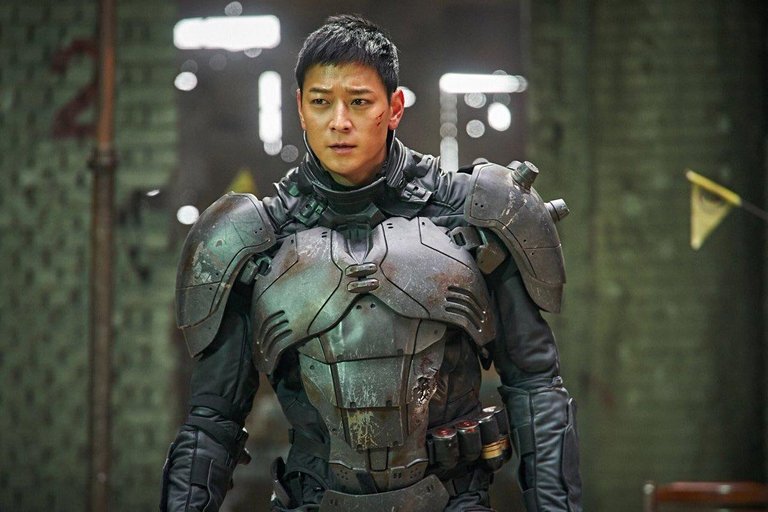
Im Joong-kyung, a Special Unit officer facing the difficult choice of loving her sworn enemy… and being a very uncharismatic leading man | Source: HanCinema
Not that Jin-Roh was devoid of romantic elements: on the contrary, much of the philosophical basis of the movie is nothing more and nothing less than a very distressing and tragic adaptation of Hans Christian Andersen's Little Red Riding Hood. Not surprisingly, the name of Mamoru Oshii's film is vaguely translatable as Were-wolf. But in its Korean version, Illang, the more, let's say, soap-opera-ish sensibility of its country of origin is incapable of depicting such a gritty and gripping ending as that of the original production on itself, leading us therefore to a somewhat more melodramatic and hopeful interpretation of the tale...
...which, unfortunately, we could not even buy.
Whether it is the result of poor acting direction or a poor casting, the fact is that neither Gang Dong-won nor Han Hyo-joo are able to convince the audience in their roles as Illang’s leading couple. The former, although he fulfills the physical part of its interpretation quite comfortably, neither creates enough empathy with the audience nor manages to justify his introversion on an emotional level, being easily thrown to the background by other more skillful thespians whenever he shares screen with them. The latter, although her interpretation as the deceased red hood’s older sister is easier to believe - not that the role demands much more than a pretty face, though - it cannot be said that she can easily make us believe the darker parts of her role.
Not that the almost null chemistry between them helps at all.
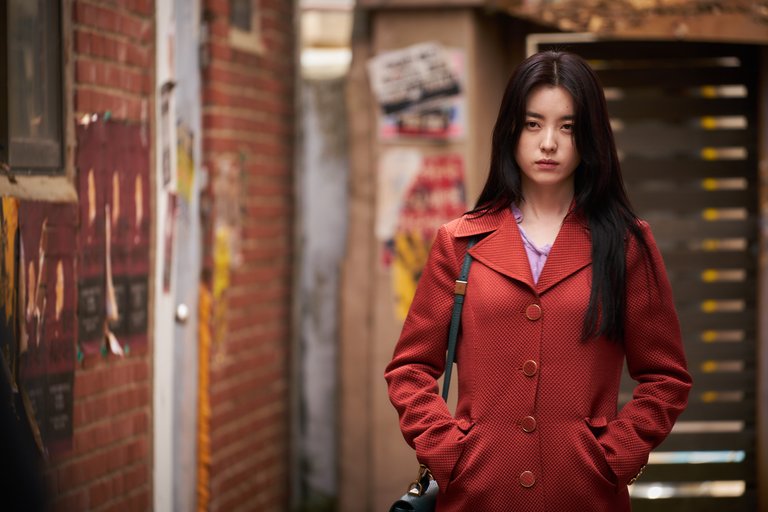
… why they didn’t give me the exploding girl’s role | Source: HanCinema
Although the supporting actors fare much better - experienced Korean actor Jung Woo-sung is undoubtedly the best of the role as the laconic, secretive and uncaring training captain of the Special Unit – in the overall appreciation of the film, there is little they can do to save an adaptation in which two clearly divergent interests are at stakes. In one hand, the director's genuine interest in creating a gripping, mature plot at the level of the original work; on the other, the studio's interest in creating a more palatable movie to Korean and worldwide audiences.
And while Illang might be considered a fairly decent blockbuster, it's not what we expected it to be - an adaptation equivalent to, or even better than, its original, as well as what Oldboy (2002) had achieved - let alone a film full of artistic value, given that it is only barely saved by the competent work of its director. Therefore, in order to see the best version of Mamoru Oshii's intriguing and dystopian work, we will have to settle for scouring his original works...
... and to watch Jin-Roh: The Wolf Brigade again.
Thank you for reading my post!
I try to answer as many comments as possible, so, feel free to leave yours in the comment section! 👇
100% original content made by yours truly,

This post has been rated by the user-run curation platform CI! In this platform users are able to manually curate content. This is done regardless of Steem Power, for both rewards and vote size calculation.
Join in at our site here!
Or join us on discord to interact with the community!
This post was given a rating of: 0.9834391878383935
This post was voted: 61.6%
Fine, I'll have to do it myself then.
Let's get you popular!!!
LOL Thanks a lot, @theironfelix! ✌
So glad that you liked it 🙏
Hi bohemian.machine,
Visit curiesteem.com or join the Curie Discord community to learn more.
OMG! Thank you for your support and appreciation, @curie! ❤
I'd have to say this is one of the best reviews of a film I have read on the blockchain. I have never heard of this movie or the source materials but you mentioning about Mamoru Oshii already hooked my curiosity to read.
It's sad to see romance is forced into this adaptation but I get the reason why. K-dramas are more popular so inserting some elements into the film was necessary to try and hook some interest in the story. Jin Roh seems like the type of art only a few would really appreciate given the philosophical themes it has. Those character designs really hyped up my curiosity. I'm going to search for an OVA about this.
Wow, @adamada! Thanks for your input, my dear. Very glad that you liked it ✌
Quite sad indeed, but I can understand why the studio made that decision. The Kerberos saga is not well known outside Japan, and it was pretty difficult that such a grim and hopeless story like Jin-Roh would connect with Korean and worldwide audiences on its original state. Nevertheless, as I recommended on the review, you can always watch Jin-Roh again. That movie simply has aged incredibly well and you can always find another meaning in each viewing.
If you're curious about the concept art and the design process of the new suits, you can check it on the lead concept artist's profile at Artstation:
Mauricio Ruiz Design
That artist has a lot of sci-fi related portfolio. Thanks for the link, he's now one of the artists I'd love to follow. As for Jin Roh, I haven't watched it yet but will do one of these days.